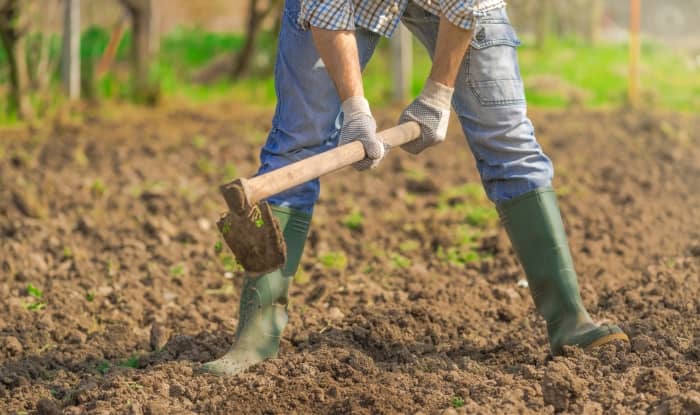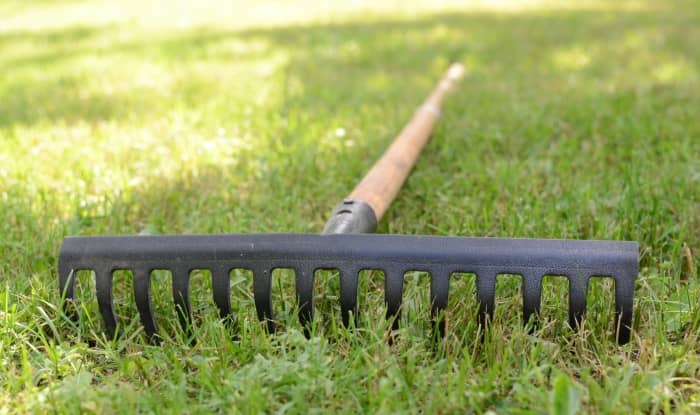Most serious gardeners have a rake and a hoe in their collection of gardening tools.
A rake is useful for a wide variety of garden tasks, including preparing garden beds, loosening and leveling soil, and raking leaves from your lawn.
And depending on the type of hoe, you can use it for weeding, digging, tilling, and shaping the soil.
So in this article, we take a look at garden hoes vs rakes. We’ll look at the different tasks the tools can be used for and their strengths and weaknesses.
Let’s dive in.
What Is A Garden Hoe Used For?
A garden hoe is a common tool used for gardening and agriculture in many parts of the world.
Garden hoes come in different types. Each type of hoe has a different shaped head, making it suitable for specific- tasks. You can use garden hoes for digging, tilling, weeding, and shaping the soil. Some garden hoes are multi-purpose and can perform all of the tasks above. Whereas other garden hoes are designed for one or two purposes.
Here are some common garden hoes and the jobs you can expect to use them for:
Draw Hoes
Draw hoes feature a rectangular blade that sticks out perpendicular at the end of the handle. To use a draw hoe for weeding, you chop the blade through the soil surface and then draw it towards you, slicing through the weeds. You can also use a draw hoe for simple moving and re-arranging of the soil. But it’s not a tool that’s built for digging.
Dutch Hoes
A Dutch hoe has a forward-facing blade that makes it easier to use for weeding than some other garden hoes. The forward-facing blade allows you to weed with a fast push-pull motion beneath the soil, cutting weed stems. The design of the hoe means that you can weed while standing without having to bend, avoiding strain on your back. You can also use a Dutch hoe for moving the soil to create furrows for planting seeds.
Stirrup Hoes
Stirrup hoes are another type of hoe designed for weeding. They take their name from the resemblance of the head to a stirrup, like you would see attached to a saddle. Stirrup hoes are also known as hula hoes, loop hoes, and scuffle hoes.
To use a stirrup hoe, you push the blade under the soil and cut weeds with a push-pull action.
A special type of stirrup hoe is an action hoe. This type of garden hoe has flexibility in the head that allows it to move slightly on the backward and forward strokes, making it more effective.
Grub Hoes
Grub hoes are digging hoes. They’re the type of hoe you want to use for digging trenches, chopping through sod, and preparing new ground for planting.
You can use a grub hoe to cut through small woody plants. And you can also chop into the soil around established weeds to cut the roots beneath the surface and partially lift them from the ground. Grub hoes are best used for removing small to medium-sized annual grasses and annual weeds with a single taproot (1). And scraping a grub hoe along the ground can sever the stems of small, young weeds and seedlings.
To use a grub hoe, lift the tool to waist height and then chop the blade into the ground.
What Is A Rake Used For?
A rake is a gardening tool used for scraping and gathering materials, often leaves or mulch. But you can also use it for breaking up and leveling soil.
Raking garden beds prepares them for seeds. As well as breaking up the soil, you can pull rocks to the perimeter, leaving a light and loosened bed top that provides better conditions for seed germination than rough soil that’s clumped together.
You can also use a garden rake for pre-weeding garden beds. By occasionally raking the soil surface for several weeks before planting, you can scrape up newly germinated seedlings.
Other uses for a rake include working pre-emergent herbicide and fertilizer granules into the soil. And you can remove thatch from your lawn to prepare it for new growth.
Rakes come in different types. A lightweight leaf rake is good enough for raking leaves without damaging your lawn. For raking leaves and leveling soil, use a standard garden rake. For removing lawn thatch, a thatch rake will improve your results. And for moving gravel, pebbles, and stones, consider getting a gravel rake.
Garden Hoe vs Rake
A garden hoe is better suited to heavier work than a rake. A rake is good for light work on the soil, leveling it, and breaking up clumps. But hoes are better suited to digging, tilling, moving, and shaping the soil, and clearing areas of sod for planting.
While a rake can clear seedlings from the soil, a hoe clears areas of small weeds that have already developed roots.
A rake is better suited to collecting leaves and clearing areas of thatch, jobs that hoes are not designed for.
Related: How To Use A Garden Hoe For Weeding
My Recommended Garden Rake
This 5 ft heavy-duty stainless steel garden rake makes it easy to level and loosen the soil. The head of the rake has 14 wide tines that are easy to insert into the soil and help dethatch your lawn. You can also use this garden tool for raking up leaves and other light debris.
Reference:
- Grubbing: Grub Hoes – https://weedcut.ipm.ucanr.edu/management-practices/grubbing-grub-hoes/



